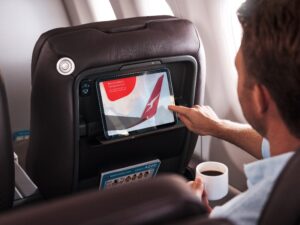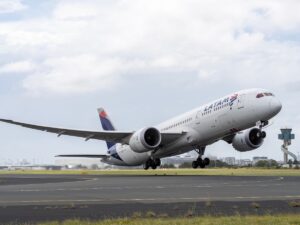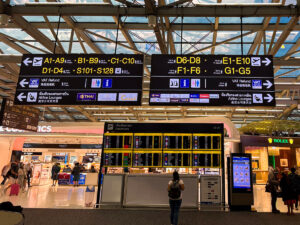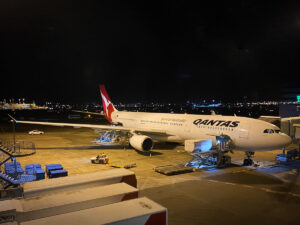
Do you remember when Boeing marketed its Boeing 787 Dreamliner as a luxurious and spacious new aircraft that would end jet lag? Boeing promised that even Economy passengers would travel in greater comfort thanks to new technology and a spacious cabin design.
Indeed, new technology on the Boeing 787 such as electronic windows and a lower cabin altitude has improved the passenger experience to some extent. Sadly, the airlines got greedy and installed 9 seats per row in Economy when the plane was designed for 8-abreast seating.
This wouldn’t be the first time that airline accountants have ruined a great aircraft design by trying to squeeze in more passengers. And it probably won’t be the last.
Right now, Boeing is in the development stages of its newest Boeing 797 aircraft. Once again, the aircraft manufacturer is spruiking the spacious design of the new plane. And the media are reporting this unquestionably, with headlines like “Boeing 797 will put an end to the economy crush” (seen recently in Perth Now). But is this a case of deja-vu?
The Boeing 797
Boeing has not yet released a final design for its new Boeing 797. But we know that it will be a mid-sized aircraft – larger than the Boeing 737 but smaller than the 787 Dreamliner. Currently, it’s expected that the Boeing 797’s first flight will be in 2024, with the first airline delivery in 2025.
Boeing has said it would be a twin-aisle plane and is touting a 2-3-2 seating configuration in Economy. This is the same configuration that most airlines use on Boeing 767s. The 7-abreast layout is relatively passenger friendly, with only one middle seat per row and direct aisle access for 57% of Economy passengers. Meanwhile, the Business and Premium Economy cabins would not have any middle seats.
But how can we be sure that airline executives and accountants won’t try to squeeze in an extra seat per row, resulting in the narrow seating squeeze we see on the Dreamliner today?
How the Boeing 787 became a “Nightmare-liner”
From the beginning, Boeing marketed its 787 “Dreamliners” as a luxurious new way to fly. Marketing material always showed images of a spacious Economy cabin with 8-abreast seating. But, in order to appeal to airlines, Boeing created a cabin that was just wide enough to squeeze in an extra seat in every row. This was originally intended as an option for low-cost carriers.
But when selling the plane to airlines, Boeing spruiked the superior economics of the plane using the assumption of a 9-across Economy cabin in its calculations. Sure enough, this is exactly what most airlines are now using.
Just two airlines, ANA and Japan Airlines – both early adopters of the Boeing 787 – fitted Economy class with 8-abreast seating. ANA has since reconfigured its planes with 9-across seats, while Japan Airlines has retained the configuration that passengers love. All other airlines opted for 9 seats per row, and this has eventually become the industry norm.
Even Qantas, which uses the Dreamliner on its marathon 17-hour non-stop flights from Perth to London, has elected to use narrower Economy seats. This results in a truly uncomfortable experience for passengers, especially on ultra-long-haul flights. AFF moderator JessicaTam learned this the hard way earlier this year.
Qantas claimed that the economics of 8 seats per row in cattle class didn’t stack up. In truth, it’s probably still more cost-efficient (on a per-seat basis) to run a Boeing 787 with 8-abreast seating than a Boeing 747 in the usual configuration. But to achieve the same revenue from a Boeing 787 with one less seat per row, Qantas would need to collect 12.5% more revenue from every Economy passenger. The airline accountants have assumed – rightly or wrongly – that most Economy passengers would not be prepared to pay that extra 12.5% in exchange for greater comfort.
Other aircraft with an economy seating squeeze
There are other cases where airline executives have decided to squeeze in more Economy seats per row than the aircraft was designed for. On the Boeing 777, for example, airlines including Emirates, Etihad Airways and Air New Zealand use a 3-4-3 layout instead of the 3-3-3 configuration the plane was originally designed for.
Most airlines use a 2-4-2 layout on their Airbus A330s. But two ultra low-cost carriers – Air Asia X and Cebu Pacific – have added an extra seat per row.
And the Boeing 767, with its standard 2-3-2 layout, resembles the intended configuration of the new Boeing 797. On this aircraft, sure enough, there are a handful of airlines that have extremely tight 2-4-2 seating in Economy. This includes Ukraine International Airlines, Nordwind Airlines and Kazakhstan’s Scat Airlines.
Let’s hope Boeing puts some more thought into the design of its Boeing 797. Because, if history is anything to go by, greedy airline accountants will squeeze as many seats onto the plane as they can get away with.
Join the discussion on the Australian Frequent Flyer forum: Yet another “New plane to put an end to economy squeeze” story













































































